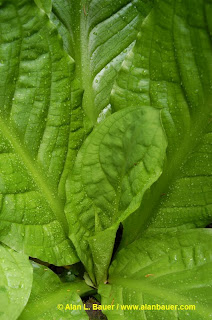 I get extra excited and antsy this time of the year. My nature wanderings take me to explore where the wildflowers can be viewed and photographed from April until at least July. While there are many spectacular native flowers that are still waiting “just around the corner” to put on their annual show, one beast of a native flower already has been showing off in areas around us and I just saw my first group of them for 2009. Skunk Cabbage (Lysichitum americanum) has long been one of the most amazing head-turning plants that I’ve ever seen!
I get extra excited and antsy this time of the year. My nature wanderings take me to explore where the wildflowers can be viewed and photographed from April until at least July. While there are many spectacular native flowers that are still waiting “just around the corner” to put on their annual show, one beast of a native flower already has been showing off in areas around us and I just saw my first group of them for 2009. Skunk Cabbage (Lysichitum americanum) has long been one of the most amazing head-turning plants that I’ve ever seen!I recall back as a child on a large farm in Oregon’s Willamette Valley when, in mid-March, these fascinating yellow “blobs” would begin to emerge from the swampy forest grounds lining our fields. I always was afraid to get near them! In early spring the skunk cabbage pokes its yellow (up to eight inches) flower and spike out of the wet area where it thrives. Sometimes, the green leaves will appear at the same time as the flowers, but most often, the bright yellow flowers are all that is seen for a week or so. The leaves are said to be the largest deciduous leaves in North America, growing to five feet in length! These large leaves were employed by virtually all western Washington tribes like waxed paper, for wrapping food, lining cooking pits, separating foods being cooked together, and drying berries on. The stinky, skunk-like smell they carry proves critical to this early blooming flower to attract small flies and gnats for pollination. Bees will pollinate the flower as well later in the spring once they become active. Native animals also rely on them as a food source as bears regularly dig up the underground rhizomes to eat, as they are packed with starch. As impressive as skunk cabbage may look, they also perform a miraculous feat each spring by generating their own heat to melt the snow away from them! If you catch the right time, you can put your finger into the cavity formed by the spathe (the bright yellow shield) and when you touch the flower head, your fingertip warms up noticeably. Biologists have found that skunk cabbage flowers produce warmth over a period of 12-14 days, remaining on average 68 degrees above the outside air temperature, whether during the day or night! This explains the remarkable sight of seeing a skunk cabbage flower emerged from the ground with snow still surrounding it, but a circular ring of snow melted away from the plant.
So put on your muddy boots or go for a drive past regional muddy wetlands and get out to enjoy the show of this "Skunk in the forest"!




No comments:
Post a Comment